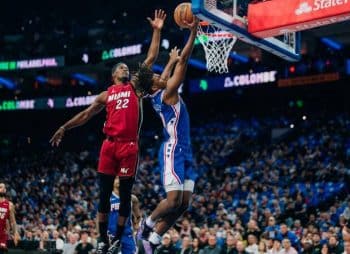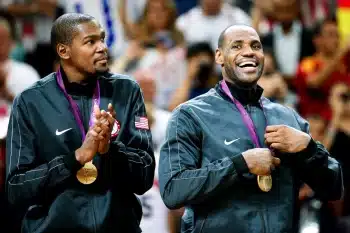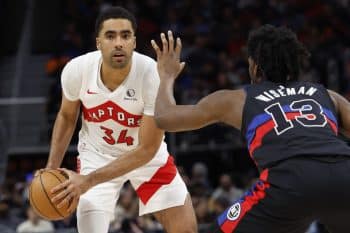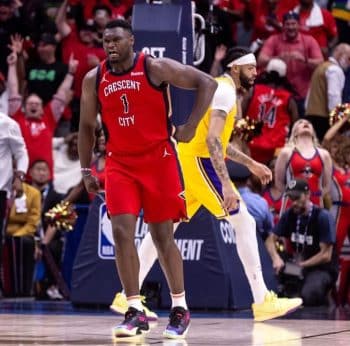NBA
How Can The Cavaliers Improve Their Roster?
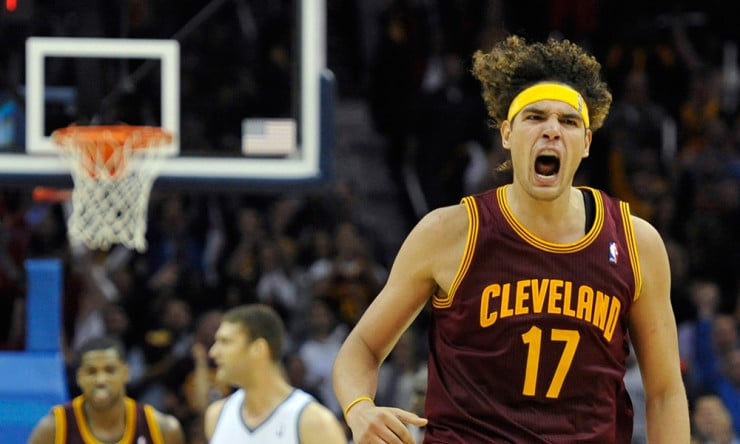
The Cleveland Cavaliers have been the league’s most newsworthy team in the first two weeks of the season, sputtering to a 1-3 start before their offense regrouped to lead the team to back-to-back wins against the Denver Nuggets and New Orleans Pelicans. Nevertheless, the first two weeks have removed any hope that this team would play passable defense out of the gate, and cast doubt on their ability to do so even in the long-term with a roster that that is missing a shot-blocker and adequate defenders in the backcourt.
With this backdrop, we turn to four key transactions the Cavaliers have made since the acquisition of Kevin Love.
• Acquired the fully non-guaranteed $5.3 million contract of Keith Bogans from the Boston Celtics for non-guaranteed players and second-round pick swaps.
• Traded Bogans and a 2018 second-rounder to the Philadelphia 76ers, acquiring a $5.3 million trade exception.
• Agreed on a three-year, $30 million extension with Anderson Varejao that locks him up through the 2017-18 season. The second year is almost entirely guaranteed, while the third year is non-guaranteed.
• Did not reach an agreement with Tristan Thompson on an extension. Thompson was believed to be seeking at least eight figures per year beginning in 2015-16. He’ll be a restricted free agent in July.
The Cavaliers currently sit at about $72.8 million in salary, $4 million below the projected luxury tax line. The reasons for the Bogans transactions are clear. The Cavs were able to acquire more salary for subsequent trades by aggregating the non-guarantees, but then were able to avoid the tax and still maintain some flexibility by exchanging Bogans for a trade exception equal to his salary. It should be noted that Dan Gilbert, reputed by some to be an owner immune to such pressures, did green light a trade that provided less future flexibility in exchange for savings.* With the trade exception, the Cavs are limited to acquiring $5.4 million in salary (the trade exception plus $100,000), whereas Bogans’ contract could have allowed them to acquire up to $6.6 million if over the tax, or $7.9 million if under the tax. Moreover, Bogans could be aggregated with other players, such as Brendan Haywood’s non-guaranteed $10.5 million contract next summer, to acquire salary up to 125 percent of their combined $15.8 million salaries.
The Varejao extension was curious in timing, even though he was set to reach free agency this summer. While he has been a Cleveland stalwart as the city’s longest-tenured pro athlete, at age 32 his best years are behind him. He has also struggled to stay healthy in his career, playing over 31 games once in the last four years. What’s more, Varejao probably isn’t even worth $10 million per season this year, as Tristan Thompson has been closing games at center for the Cavs. The cap will be going up in 2016-17, but $10 million a year is still close to quality starter money even under a $90 million projected cap (assuming, as appears increasingly likely, there will not be smoothing of the money from the new television deal and it will hit all at once in 2016-17). As a borderline starter now, the chances of him being worth that kind of money at age 34 are slim.
By contrast, there would have been almost no risk to Cleveland by letting him play out the year and become a free agent. Even if he stays healthy all year, it is difficult to believe Varejao would command a two-year deal for $10 million a season on the open market next summer. Even if he were to receive such an offer, it is difficult to believe that a Cleveland fixture playing on a stacked team with LeBron James wouldn’t at least give the Cavs a chance to match or exceed an offer in free agency. And by signing Varejao now, they take on all the risk of age- or injury-related performance decline, in exchange for almost no chance of locking Varejao up at a below-market deal.
The Varejao extension should not be evaluated solely in a vacuum though. The opportunity cost for next season and beyond is the key consideration. LeBron James and Kevin Love have player options for 2015-16, which they will almost certainly decline so they can sign new maximum contracts. Kyrie Irving’s maximum extension kicks in, and Tristan Thompson will likely be re-signed for something into eight figures. That alone will put the Cavaliers around $90 million in payroll, about $9 million above the projected luxury tax line.
The Cavaliers also have Haywood’s non-guaranteed final season of his contract, which rises to $10.5 million on their books after only $2.2 million this year for the Cavs.* The Cavaliers can use Haywood’s contract to match salaries, and use their protected first-rounder from Memphis** and/or Dion Waiters as a sweetener to pick up another big man. Players with 2016 expiring contracts like Roy Hibbert, David West, Al Horford, Timofey Mozgov or Nene might all conceivably be available for such a package if their teams fear losing them as free agents.
If the Cavaliers were to acquire one of the previously mentioned players, their salary structure might look something like this.
That is a payroll over $102 million, without accounting for more salary potentially obtained via the Bogans trade exception, or a signing by the taxpayer mid-level exception of $3.4 million. A $102 million payroll would mean a luxury tax payment of $46 million, and it would rise at a rate of $3.75 per $1 in salary from there, with an additional 50 cents per $1.00 for every $5 million increment over $106 million in payroll.* Paying $9.6 million to Varejao in 2015-16 could cost Dan Gilbert more than double that in luxury tax payments. That will be quite a bitter pill if Varejao declines or is injured.
As a tax team, the Cavs’ transactions will be limited. They will not be able to engage in sign-and-trades since they have a team salary above the apron (a figure $4 million above the tax line), eliminating perhaps the most useful potential application of Haywood’s contract—obtaining a free agent rim protector such as Marc Gasol, Robin Lopez, Hibbert (if he opted out) or Omer Asik. And they can only acquire players up to 125 percent of the traded salary, instead of for Haywood’s $10.5 million salary plus $5 million were they not in the tax. Other players could also be added to the trade to increase the amount received, of course.
The options to improve are somewhat limited for the Cavs aside from that Haywood trade. Would it be otherwise if the Cavs had not extended Varejao? Possibly, although it would also require moving on from Tristan Thompson and renouncing his rights next summer. There are off-court considerations here, as Thompson is a client of Klutch Sports, an agency with which James is heavily involved. Thompson has his strengths and can be a dominant offensive rebounder, but his lack of shooting range and ball skills make him a center offensively despite his power forward size. It is hard to imagine him holding up at the rim or on the block the way a center needs to defensively, even with the improvement most young players experience. The Cavs also have Kevin Love already at power forward. Moving on from Thompson would be reasonable if the Cavs could replace him with a better option at center or shooting guard. That is a decision that did not have been made until they knew another option were available at the onset of free agency. Waiting to extend Thompson made sense, especially if he was not going to come at a discount. But it would have made more sense in conjunction with foregoing an extension for Varejao as well.
If the Cavs would have parted ways with Thompson and Varejao, the payroll looks like this during free agency, accounting for cap holds to James and Love once they have opted out. (Those cap holds are what they likely would eventually sign for anyway.)
With a payroll of about $78 million, Cleveland could deal Haywood in a sign-and-trade, so long as the team salary did not exceed the $85 million apron at the conclusion of the trade. The Cavs would then be hard-capped during the year at the apron. Depending on the amount of salary acquired (or whether they just make a trade rather than a sign-and-trade), they might also have been able to use some combination (though likely not each) of the Bogans trade exception, the full mid-level exception or the bi-annual exception. The Cavs could also have opened up maximum cap room in the unlikely but terrifying scenario that Kevin Love leaves as a free agent.
It may well be that Varejao and Thompson play well and the Cavs want to bring this whole band back together next season. But as some of the early struggles have shown, success is by no means assured. It probably made more sense for the Cavs to wait to extend Varejao and keep their options open for next summer, especially considering they are not sure how this new team is going to play as a unit. But now that Varejao’s extension has assured the Cavs of a high payroll, it probably makes sense to re-sign Thompson as well since they will have no way to replace him so far over the cap. They will also need him as insurance for Varejao’s potential health issues.
The Cavs’ lack of flexibility remains an issue as we look further ahead. Return to the 2016-17 projection:
While the rest of the league will be flush with cash, assuming the cap explodes to $90 million in 2016, the Cavaliers will likely be looking at another big tax bill. Given the amount the cap is projected to rise in 2016, Love and James may both sign similar contracts to LeBron’s most recent deal, two years with a second-year player option. This will allow them to become free agents again in 2016, when their individual maximums should be about $30 million and $25 million respectively if the cap rises to $90 million with no smoothing. Between James, Love, Irving, Varejao, Thompson’s new contract, the potential Haywood trade booty, a new contract for Waiters* and various smaller contracts, the Cavaliers are looking at about $118 million in payroll for 2016 and a huge tax bill even with the exploding cap. Now there are various permutations by which they could avoid being a tax team in 2016, but the chances of adding a player using cap room (which would require a team salary well below $90 million in the summer of 2016) are low indeed with this salary structure.
The coming years are going to be fascinating for the Cavaliers. They are not without avenues for improvement, as Waiters, the Haywood contract and the Memphis pick could net some juicy pieces in a trade. But to make that happen, it seems almost certain that Gilbert will be paying massive luxury tax bills. The early extension for Varejao may greatly complicate the Cavs’ task going forward.


